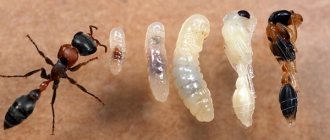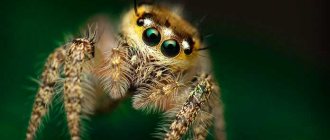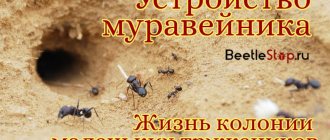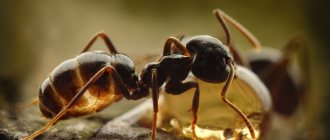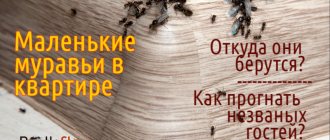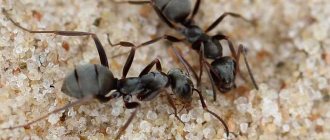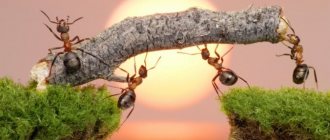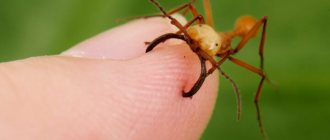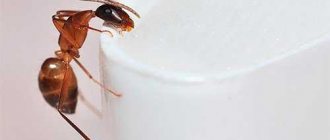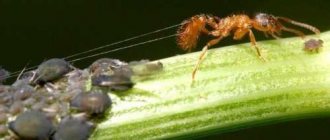Nomadic ants, regularly migrating in colonies of millions, live in the tropical zones of Africa, Asia and America. Insects do not build permanent nests; their sedentary phase of life lasts no more than 2-3 weeks. They move during the day, and for the night they set up a bivouac from their own bodies, in the center of which is the uterus. A horde that travels 1-3 km leaves nothing alive behind it. Powerful mandibles cut not only insects, but small mammals and birds. Stray ants are called killers, often exaggerating their danger.
Nomadic ants or Siafu ants
0 These ants move in large columns. Everything that gets in the way of the soldiers is immediately destroyed. With their powerful jaws, these insects grab woodlice, beetles, and larvae running past, tear them into pieces and carry them to the colony. If nomadic ants encounter a larger prey, for example, a mouse, lizard, or snake, then they fall on it in a moving black mass, and not a trace of the animal remains. In Africa they are considered one of the most widespread and dangerous predators. The peculiarity of nomadic ants is that they do not have an anthill. Their reproduction occurs in temporary bivouacs, which are formed by working ants, connecting to each other with their jaws. This bivouac has a spherical shape. It seems that there is chaos going on there, but in reality everything is organized there. These ants spend most of their lives roaming, looking for food, which is where their name comes from.
Benefits and harm to humans
Residents of villages located in tropical forests are well aware of the ability of an ant colony to destroy everything. If their housing becomes an obstacle to these arthropods, they quickly take the livestock and try to leave the village for a while.
After the end of the invasion of tramps, all types of insects disappear in the house of each resident; they destroy flies, fleas, cockroaches, spiders, and rats. Since nomads do not consume vegetation as food, the field is safely freed from phytophages - plant pests.
Despite such benefits of vagrants, they can also pose a danger to humans. If people get in their way, they risk being bitten by hundreds of representatives. Nomads do not bite a person right away, but act a little more harshly - crawling under clothes, they begin to bite at the same time.
People who are prone to allergic reactions may experience anaphylactic shock following such attacks. But it is worth noting that attacks on people and animals are rare for them; other types of insects are considered the main prey of stray ants. Tropical tramps are engaged in clearing forests from the corpses of living creatures, and also destroying individuals that are sick or weak.
Description
Several related groups of true ants share a similar lifestyle called the nomadic ant syndrome. Their characteristic feature is regular migrations. Numerous colonies of insects, reaching several million, move within 1-2 weeks. They carry eggs, larvae, and the queen with them. Nomadic individuals do not build anthills; by interlocking bodies, they build a nest for numerous family members and the queen.
Adult
The body of an adult ant consists of three sections: head, chest (mesosoma) and abdomen. The stalk connecting the thoracic segments and the abdomen is called petiole. The chitinous exoskeleton protects and supports the insect's body. On the ant's head there are antennae consisting of 8-10 segments. These are sensory organs that detect vibrations and chemical odors.
Interesting fact. Most wandering ants do not have visual organs or they are greatly reduced. Blind insects navigate in space using their antennae. They communicate with each other by releasing pheromones.
The upper jaws of mandible ants vary in size, but are always well developed. In working individuals, they are designed to carry eggs and larvae and food. For soldiers, this is a powerful weapon. Strong mandibles help tear apart enemies. Insects have 3 pairs of legs; their paws have claws that help them move along a vertical surface. The abdomen of some species ends in a sting.
Interesting fact. Soldier ants of the genus Dorylus do not open their closed jaws even after death.
Communication system
There are 75 glands in the ant's body; they secrete various substances, including pheromones and repellents. Nomadic species have dozens of special signal odors produced in various situations. With the help of pheromones, scouts indicate the direction of movement of the entire column and report the location of the prey.
Ant hierarchy
The nomad ant family consists of hundreds of thousands or millions of individuals. They all obey a strict hierarchy and act as a single harmonious organism. The basis of a large colony is made up of worker ants. These are infertile females. Specialized groups are formed from them: workers, foragers, scouts, soldiers. Males are several times larger than representatives of the working caste. The main figure of the family is the queen. She is the only female involved in giving birth to new members of the colony. The queen's lifespan is 15-20 years.
Enemies
The only one is the praying mantis. One of the team sacrifices himself, rushes into the offender’s mouth, releasing poison.
At this signal, the nomadic ants gather and then nothing can save the praying mantis. They themselves pose a danger to those who get in the way, especially those in the center of the stream, so they are not hunted.
The mortal threat to people is exaggerated in the film industry. You can actually suffer from bites if you are allergic to them. But no cases of human murder have been recorded. When they come across residential villages, people flee for their lives, because after an ant attack, livestock does not survive, and rodents run away.
They do not attack randomly. They spread silently throughout the body, biting at once according to a conventional sign. They have no vision. Nomadic ants of South America hear perfectly and feel many kilometers ahead.
Orderlies, as they destroy agricultural pests and wounded animals. These are the most dangerous predators on the continent. They follow chemical trails left by their relatives. For allergy sufferers, meeting them risks anaphylactic shock and skin rashes. The main female has no rights, although she is called the queen.
Bullet Ant
0 The name of these ants is due to the fact that when bitten, a very strong pain occurs, which, like a bullet, hits the body. The venom of these ants contains a powerful toxin - poneratoxin. Once a bullet ant bites, the pain lasts for 24 hours, which is why they are also called “24 hour ants.”
0
They have a very strong sting and poison, which is why they got their name. On the Schmidt scale, the pain from the bite of this ant reaches the highest level of 4, that is, it exceeds the pain from any other insect bites. These ants are among the largest on the planet: the body length of the female reaches 3 centimeters, and the working individual reaches 2.5 centimeters.
0
The stinging force of the “bullet ant” on the Schmidt Sting Pain Index scale corresponds to the highest, 4th, level. Ants live 24 hours in South America. Some Indian tribes use them to conduct terrible male initiation rituals, during which sleeves with these ants are placed on the boys' hands. After the ceremony, the hands may not move for several days, become insensitive and turn black. This type of ant is used by local tribes for painful rituals.
Varieties of dangerous ants
In our regions, we often encounter ants, but all of them do not pose a danger to people, which cannot be said about some species living in tropical climates. There are species that contain aggressive poison. The following are considered dangerous:
- Siafu are nomadic army ants. Habitat: Australia. The insect has powerful jaws. Like other species of nomadic ants, there is no permanent anthill. Insects build a bivouac (temporary housing), which consists of the bodies of working individuals. Bites are dangerous for humans as they can cause allergies.
- Bullet ants. These insects have a very strong poison - ponerotoxin. The bite causes terrible pain that does not subside within 24 hours. This type of insect is found in the tropics and subtropics of the South American continent. Indian tribes used these ants for initiation rites. A bracelet, which was covered with insects, was attached to the young man’s hand. The ants bit the boy, after which his limbs were paralyzed for 2-3 days, and the bite sites turned black. The worst thing is that the young man must go through this execution 20 times, and only after that he can be considered a real man.
- Fiery. This type of ant is very dangerous to humans. In one year, about 20 deaths were recorded after a bite, which caused a severe allergic reaction. Habitat: Asia, southern Europe and America. Ants easily adapt to their environment, colonizing unknown territories. The fire ant's venom is called solenopsin. The bite feels like pain from a burn and provokes the formation of a tumor.
- Bulldog ant. A large insect that is very poisonous. Three out of a hundred people bitten experienced anaphylactic shock. It is very difficult to predict what the body’s reaction to such a poison will be, because it is very different in its chemical composition from the toxins contained in the sting of bees and wasps.
Nomadic ants, the description of which was discussed in the article, are truly amazing representatives of the animal world. One can only envy their organization and coordinated work.
Classification
There are three subfamilies of tropical nomad ants in the world. The main classification occurs according to habitat:
- Aenictus are small to medium-sized insects common in Asia, Australia and Africa. Working individuals are yellow-brown in color, their body length does not exceed 3.5 mm. Males and females of the genus are much larger, reaching 25 mm. Differences are also manifested in the anatomical structure - in working ants the stalk between the chest and abdomen consists of two segments, in males and females it has one. The subfamily unites about 180 species.
- Dorylinae - main habitat regions are tropical Asia and Africa. The large group includes 800 species. The most famous genus is Dorylus. Depending on the hierarchy, ants vary significantly in size. Workers 3 mm, soldiers 13 mm, males 30 mm, females 50 mm. The number of individuals in one migrating colony is about 20 million.
- Ecitoninae - insects are found in the New World in the United States, the southern border of their habitat is Argentina and Chile. American raptors spend most of their lives traveling and hunting. During migration, places in the column are clearly allocated. Worker ants move in the middle and bear offspring. Soldiers on the sides protect their relatives from enemy attacks. The color of the imago ranges from brown to black.
Lifestyle Features
Nomad syndrome exhibits the behavior and reproductive characteristics of insects.
Among the main signs of the syndrome are the presence of:
- Collective foraging;
- Construction of a temporary bivouac nest;
- Regular changes in the phase of settling down and migration;
- Subordination of reproductive cycles to the family movement schedule.
The size of a colony can reach several million relatives, who require large amounts of food. Since prey in one place is impossible in such volumes, insects spend their lives migrating.
The colony moves like a running stream, from 30 to 100 centimeters wide and up to 45 meters long. Movement is carried out at different speeds depending on the place where the nomads live. The African ant Dorylinae reaches a speed of 20 meters per hour, but the American Ecitoninae is much faster - up to 150 meters per hour.
The onset of twilight requires the construction of a bivouac - a temporary nest in the shape of a ball, and it consists of the bodies of working class ants; it is built in secluded places. The queen and offspring are placed inside the bivouac. The shelter has a couple of entrances. The bivouac itself can be approximately one meter in diameter and requires about 500 thousand ants to build.
The African species Siafu digs a nest in soft lands. Blind arthropods are capable of preparing a shelter for a huge family of up to 20 million relatives in the shortest possible time. A distinctive feature of arthropods is the absence of a sting; mandibles act as a replacement; the painful bite is unpleasant even for an elephant. The jaw easily cuts the cover of an insect or animal, tearing off pieces of flesh.
The nomadic ant, regardless of age, eats only meat. Vagrants obtain food for the larvae such as spiders, caterpillars, beetles, locusts, and scorpions. The predators themselves eat birds that make nests on the ground, small vertebrates - lizards, snakes, rodents. Representatives clean the found corpses of living creatures, leaving only their bones.
Black bulldog ants
0 These insects are quite large, but they became famous not for their size, but for their bites. Statistics show that bulldog ant bites kill more people in Tasmania every year than snakes, spiders and sharks combined.
0
The pain from a bulldog ant bite can last for days. Such a bite provokes a powerful allergic reaction - more than 3% of victims develop anaphylactic shock. It is impossible to find out in advance what reaction the body will have. Even a person with a normal reaction to a bee or wasp sting can be fatal after being bitten by a bulldog ant. These ants are very primitive compared to their counterparts, perhaps that is why they are so poisonous. They have small colonies of several hundred individuals.
Ants are hymenopteran insects with complete metamorphosis. This means that their life begins with the egg phase, then the larva emerges. Ants turn into adults after pupation. The formation of eggs begins during the period of sedentary life. The fertility of a female is 200-300 thousand pieces. The embryonic period lasts up to three weeks. By the time of the new migration, larvae emerge from the eggs. This process is synchronized by the development of pupae; adults emerge from the cocoons of the previous clutch. To feed the larvae, the colony sets off. By the time they pupate, the column finds a place to stay.
Once a year, the queen makes a special clutch from which reproductive females and males emerge. As they age, they leave the family and form their own colonies.
Reproduction
When the soldier ants take a short break, the female begins laying eggs. While the queen is laying eggs, the bivouac exists for three weeks. They feed her, her belly increases in size and she lays offspring. The working class takes the larvae, carries them on themselves, hiding them from the sun, constantly licking them.
There are only four stages of transformation from egg to adult. In the pupal position, they become overgrown with a cocoon, before the adult hatches. The budding method allows the creation of new castes with a queen.
Fire red ant
0 These ants are considered the most dangerous ants in the world. This is not even due to painful bites and strong poison, but to their ability to take root in various conditions. They are spreading around the world at lightning speed.
0
There are known cases of a person being stung by one ant with serious consequences, anaphylactic shock, even death. Red fire ants are native to Brazil, from where they traveled on trade ships to China, the USA and Australia. In addition, they are trying to destroy them in Taiwan, the Philippines and Hong Kong, but so far the ants are winning. When a fire ant bites, a toxin, solenopsin, penetrates the wound. According to the Schmidt pain scale, this pain corresponds to the pain from a burn, which is where the name comes from. Every year these ants bite thousands of people; almost all victims experience a severe allergic reaction, and in isolated cases anaphylactic shock occurs.
In similar ways, these ants were accidentally introduced to Australia in 2001. Fire ants bite both wild and domestic animals. About $5 billion is spent annually in the United States on medical and veterinary care after being bitten by these ants. People must understand that all ants, even dangerous and aggressive ones, are necessary for nature. These insects are pest controllers, they destroy sick and dying insects and animals. The concepts of “harmful” and “dangerous” should not be confused; even the most dangerous ants deserve respect.
Dolichoderus attelaboides
The tree ant Dolichoderus attelaboides can best be described in two words: angular and lanky. Nature has endowed these large, about ten millimeters long, red-black insects with an elongated neck, massive legs and an elongated pronotum.
Alex Wild
To build a nest, Dolichoderus attelaboides chews wood and impregnates it with a special enzyme, resulting in thin cardboard slices. They use them as building material.
And in conclusion, I would like to remind you that not all insects that live in the rainforests of the Amazon and look like ants are actually ants. For example, termites (top photo on the left) have something in common with ants in their lifestyle and social behavior, while they do not have the thin ant waist, and their closest relatives are not ants at all, but cockroaches.
Alex Wild
Many beetles (top right photo) pretend to be ants for one reason or another, and so do various types of spiders (bottom two photos).
Insect feeding
The favorite delicacy of ants are insects such as:
- wasp;
- bee;
- termite.
Nomadic ants of the African continent also feed on carrion, and it does not matter at all whether the corpse of an animal they eat is large or small. Stray insects mercilessly absorb everything that comes their way:
- different types of insects;
- snake;
- bird's nests;
- small invertebrates;
- amphibians.
The ants pierce the victim and inject it with a dose of a toxic, poisonous substance. Since the speed of insects is not too high (up to 20 km/h), weak, slow and wounded animals most often become their prey.
Role in nature
Nomads are an integral part of many tropical ecosystems.
Being both predators and scavengers, insects perform the function of forest orderlies, clearing it of sick animals and decaying remains.
Some animals have learned to use ants for their own purposes. For example, a bird such as the ocellated ant accompanies an ant colony, catching and eating those insects that are frightened by the ants and run away.
Nomads also serve as food for some species of animals, birds and even insects. The worst enemy of ants is the praying mantis. To protect their family from a predator, one of the ants, sacrificing its life, rushes at the mantis, distracting it from its relatives. At this time, the victim releases a special secret that attracts his fellows. Recognizing the signal, the whole family attacks the praying mantis and bites it to death.
Habitat area
Hide Announcement: Reproduction Lifestyle, nutrition Enemies Interesting facts Life expectancy African killer ants live in the tropical forests of the African continent, North and South America and Asia.
They have a color consisting of coarse fibers - red. In each bivouac (an anthill that the wanderers themselves form by interlocking limbs) a queen sits in the depths. Its length reaches 5 cm. It is distinguished by a huge belly. Every day it produces thousands of nomads, preventing their numbers from decreasing.
Source
Birds
African white-crested kalao
The African white-crested kalao is one of the representatives of hornbills and lives in the humid forests of Central and Western Africa.
The body length ranges from 70-80 cm. The weight of the male is 279-315 g, the female - 276-288 g. The color of the head is white, with black spots, the rest of the plumage is black, with a metallic sheen. Only the tail feathers have white spots at the tips.
African brilliant teal
The African glossy teal, also known as the pygmy goose, is native to sub-Saharan Africa. It is the smallest game in Africa, and one of the smallest in the world (average weight is about 285 g, and the wingspan is 142-165 mm). Inhabits water bodies, feeding on aquatic vegetation and invertebrates.
Although African glossy teals have bills like geese, they are more closely related to dabbling ducks and other Anatidae. Feather color includes the following colors: black, white, red and green.
African vulture
Lives in savannas located south of the Sahara. The African vulture has a small number of feathers on its head and neck, very wide wings, and short tail feathers. Body weight is from 4.2 to 7.2 kg, length is 78-98 cm, and the wingspan is in the range of 1.96-2.25 m.
Like other vultures, this one is a vulture, feeding mainly on the carcasses of animals it finds in the savannas. African vultures often fly in flocks.
African penguin
The African penguin, also known as the spectacled penguin, lives in the waters of southern Africa. Like other penguins, this species is flightless, with a streamlined body and wings flattened into flippers for its marine habitat. Adults weigh on average 2.2-3.5 kg and reach a height of 60-70 cm. They have distinctive pink spots (glands) above the eyes that help them cope with changes in temperature.
African penguins are excellent divers and feed mainly on fish and squid. This species is endangered and is very popular among tourists.
Wavy Astrild
The Wavy Astrild is a small bird from the order Passeriformes. Its homeland is sub-Saharan African countries. However, this species has been introduced to many other regions of the world.
The Wavy Astrild's body length is 11-13 cm, with a wingspan of 12 to 14 cm and a weight of 7-10 g. This bird has a slender body with short, rounded wings and a long tail. The plumage is mostly grey-brown and the beak is bright red.
Common social weaver
These birds live in the savannas of South Africa, Namibia and Botswana. They build large communal nests, which is rare among birds. Weaver nests are among the most spectacular structures built by birds.
The body length is about 14 cm, and the weight is 26-32 g. Sexual dimorphism is not pronounced. The color of the feathers is pale brown, with dark patches.
Tsetse fly
This African fly is also one of the most dangerous insects in the world, since it is capable of transmitting the causative agent of sleeping sickness to a person through a bite. This disease has been known for a long time, but doctors have never found a reliable way to cope with it. As the disease progresses, a person experiences significant disturbances in the functioning of the nervous system, drowsiness is observed, and consciousness becomes confused. In the most severe cases, coma and subsequent death may occur. According to statistics, about half a million people in sub-Saharan Africa are already infected with this disease, and most of them face a painful, long death.
Lonomiya
Among the slow and seemingly indifferent caterpillars there are also dangerous creatures. The caterpillar of the small nocturnal moth Lonomia lives in the rainforests of South America, and local residents nicknamed it the “lazy clown.” This hairy caterpillar is wonderfully camouflaged among greenery, so you can accidentally suffer from contact with it. The caterpillar has a very attractive appearance - bright, beautiful, covered on all sides with long fibers. But they contain a very strong toxin, which is so strong that the affected person’s blood clotting is very quickly impaired, the kidneys fail, and hemorrhage may occur in the brain and other organs. Red blood cells begin to break down, and multiple organ hemorrhage occurs. Outwardly, this is expressed in the appearance of large bruises on the skin. If a person manages to “pet” several of these caterpillars at once, he will almost certainly die - a massive brain hemorrhage will quickly begin, which will lead to a stroke and death of the victim. Unfortunately, Lonomia caterpillars often appear in orchards, where Brazilian farmers accidentally stumble upon them. As a result, 10-30 people die a year, and many more remain disabled.
Notes
- Striganova B. R., Zakharov A. A.
Five-language dictionary of animal names: Insects (Latin-Russian-English-German-French) / Ed. Doctor of Biology sciences, prof. B. R. Striganova. - M.: RUSSO, 2000. - P. 293. - 1060 copies. — ISBN 5-88721-162-8. - Ants (Russian) (inaccessible link). Online encyclopedia Around the World. Access date: April 11, 2011. Archived April 14, 2012.
- ↑ 1 2 3 4 5 6 7 8 Brady Seán G., Fisher Brian L., Schultz Ted R., Ward Philip S.
The rise of army ants and their relatives: diversification of specialized predatory doryline ants (English) // BMC Evolutionary Biology (English) (Russian: Journal - BioMed Central (English) (Russian, 2014. - Vol. 14. - P. 2-14. - doi:10.1186/1471-2148-14-93. - ↑ 1 2 3 4 Borowiec, ML
Generic revision of the ant subfamily Dorylinae (Hymenoptera, Formicidae) (English) // ZooKeys: Journal. — 2016. — Vol. 608. - P. 1-280. - doi:10.3897/zookeys.608.9427.. - Elzinga, RJ 1993: Larvamimidae, a new family of mites (Acari: Dermanyssoidea) associated with army ants. Acarologia, 34: 95-103
- Elzinga RJ 2006. Army Ant Mites: the Most Specialized Mites Found on Any Social Insect
- Tortoise Mites, but usually not the biting kind
- Hlavač, P.; Newton, A.F.; Maruyama, M. 2011. World catalog of the species of the tribe Lomechusini (Staphylinidae: Aleocharinae). Zootaxa (ISSN 1175-5326), 3075
: 1-151. Preview - Loiácono Marta S., Cecilia B. Margaría, and Daniel A. Aquino.
Diapriinae Wasps (Hymenoptera: Diaprioidea: Diapriidae) Associated with Ants (Hymenoptera: Formicidae) in Argentina (English) // Psyche: Journal. — 2013. — Vol. 2013, no. Article ID 320590. - P. 1-11. — ISSN 0033-2615. - Lorite P. & Palomeque T. Karyotype evolution in ants (Hymenoptera: Formicidae) with a review of the known ant chromosome numbers. — Myrmecologische Nachrichten (Wien). — 2010. Volume 13, Pages 89-102. (Accessed: August 12, 2016)
- Brown WL, Jr.
Contributions toward a reclassification of the Formicidae. V. Ponerinae, tribes Platythyreini, Cerapachyini, Cylindromyrmecini, Acanthostichini, and Aenictogitini (English) // Search. Agriculture (Ithaca, New York): Journal. - 1975. - Vol. 5(1). - P. 1-115. - ↑ 1 2 3 Bolton B.
Synopsis and classification of Formicidae. (English) // Mem. Am. Entomol. Inst. - Gainesville, FL: American Entomological Institute, 2003. - Vol. 71. - P. 1-370. — ISBN 1-887988-15-7. - Brandão, C.R.F.;
Diniz, J.L.M.; Agosti, D.; Delabie, JH Revision of the Neotropical ant subfamily Leptanilloidinae (English) // Systematic Entomology: Journal. - 1999. - Vol. 24, no. 1. - P. 17-36. doi: 10.1046/j.1365-3113.1999.00064.x - Baroni Urbani, C., Bolton, B., & Ward, P. S. (1992). The internal phylogeny of ants (Hymenoptera: Formicidae). Systematic Entomology, 17, 301–329.
How to recognize
Ant bullet
The bullet ant is one of the largest of its genus.
- The female grows up to 30 mm. The body length of the remaining individuals ranges from 18-25 mm.
- Color can vary from red-brown to deep brown. Males are smaller in size and lighter in color.
- The uterus has a large abdomen for bearing eggs.
- The body consists of 3 segments.
- There are very small needle growths all over the surface.
- The structure is completed by an impressive sting, with which the insect injects poison.
Looking at the photo of a bullet ant, you can clearly see its powerful mouthparts. It serves not only to capture prey, but also to carry food.
An interesting fact about ants concerns their ability to communicate with each other. Bullets have another ability - the ability to make sounds. Before an attack, individuals always hiss, warning of an attack. They do not attack themselves. An ant can bite only if it senses a threat to its nest.
Lonomiya
Among the slow and seemingly indifferent caterpillars there are also dangerous creatures. The caterpillar of the small nocturnal moth Lonomia lives in the rainforests of South America, and local residents nicknamed it the “lazy clown.” This hairy caterpillar is wonderfully camouflaged among greenery, so you can accidentally suffer from contact with it. The caterpillar has a very attractive appearance - bright, beautiful, covered on all sides with long fibers. But they contain a very strong toxin, which is so strong that the affected person’s blood clotting is very quickly impaired, the kidneys fail, and hemorrhage may occur in the brain and other organs. Red blood cells begin to break down, and multiple organ hemorrhage occurs. Outwardly, this is expressed in the appearance of large bruises on the skin. If a person manages to “pet” several of these caterpillars at once, he will almost certainly die - a massive brain hemorrhage will quickly begin, which will lead to a stroke and death of the victim. Unfortunately, Lonomia caterpillars often appear in orchards, where Brazilian farmers accidentally stumble upon them. As a result, 10-30 people die a year, and many more remain disabled.
Danger of bites
The sting of a stray ant is quite painful, but do not think that they can pose a great danger to a healthy person. Those who are prone to acute allergic reactions should be in contact with them with special caution. Nomad bites can lead allergy sufferers to anaphylactic shock with suffocation and even fatal intoxication.
Those who fall into the middle of a family of vagabonds face the risk of being severely bitten. This fate is often faced by sick and weakened people who cannot disappear from the path of a column of nomadic arthropods in time.
Killer ants have become the main characters of horror films (for example, the film Marabunta), in the plot they seem to be especially cruel, leaving behind gnawed bones, but this is just fiction and the rich imagination of the screenwriters.
Vagrants are an important part of the ecosystem of those inhabited areas. With their help, forests are cleared of animals that are sick or weakened, as well as carrion. In addition, nomads act as food for certain animals and birds. Therefore, it can be concluded that nomadic arthropods play an important role in food chains and the environment.
LIFESTYLE
Wandering ants live in the thick of the tropical forests of South America. They lead a terrestrial lifestyle and differ from all other social insects in that they constantly migrate. The colony is led by a single female, the queen, who lays eggs. The rhythm of life of a colony of wandering ants consists of 30-40 day cycles.
For about this time, the ants stop, rest and eat, and then continue their journey again. In exceptional cases, when an unexpected delay occurs, the ants build a temporary nest in a well-lit place.
Wandering ants travel only during the day; at night they set up a temporary camp. From their bodies, ants form a spherical nest, hollow inside. The queen and larvae are placed in it. During dormant periods, when the ants live in one place, the queen lays about 100,000 eggs daily in her nest. Workers remove the larvae from them. Working individuals also take care of them.
Over time, the number of adult ants in the colony increases so much that they are no longer able to provide themselves with enough food while living in one place. This is why ants hit the road. The period of migration for these ants continues until the larvae turn into pupae. Then the colony's need for food is reduced, since the pupae do not require food. The ants set up a temporary camp again. No later than a week later, the queen lays eggs again and the cycle repeats.
